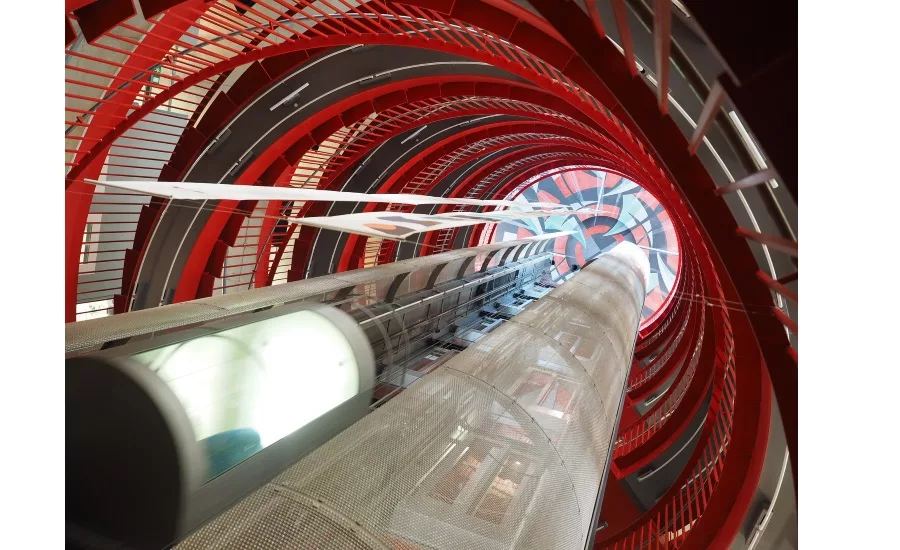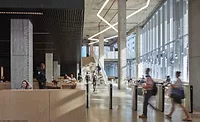The future of vertical transportation: secure, touchless and predictive

Most people don’t think about vertical transportation until they’re standing in front of a bank of elevators impatiently waiting for the next cab to arrive. But elevators not only make life in cities more livable, they move more than 325 million passengers a day. Or, at least they did before the pandemic hit.
They also represent a growing security and safety concern for security professionals, property owners and building managers. In multi-story buildings it’s not enough to control access to the building; it’s becoming essential to control where people go when they are inside the building. Elevator security makes that possible.
Prior to the pandemic, enhancing elevator security and efficiency were the key areas of focus of the industry, particularly through the implementation of destination dispatch technology.
Destination dispatch and elevator security
Destination dispatch is an intelligent control strategy used in multi-elevator installations that increases elevator efficiency and reduces wait times by grouping passengers based on their destination. If you can put passengers traveling to the same one or two floors in the same cab, rather than having a random grouping, the elevator has to make fewer stops and operates more efficiently.
These systems provide a number of opportunities to enhance elevator operation. For example, they can segment tenants to prevent passengers from competitive companies located in the same building from riding in the same cab together. They can also be used to assign VIP or priority status to some people, designate a default destination based on a tenant’s residence or office location, and provide data that can be used in security auditing.
In short, destination dispatch systems are making vertical transportation more efficient for building owners — elevators account for up to 5% of a building’s total energy consumption — while offering features that increase convenience for building users.
Destination dispatch technology will also play a growing role in elevator security. By integrating destination dispatch or building access control systems with elevator security solutions, security professionals can control which floors visitors are authorized to travel to, adding a layer of security to vertical transportation.
The touchless experience
Like almost everything else in our lives, the experience of using elevators will be permanently altered by the pandemic.
Think about returning to work in a multi-story building after an extended period of sheltering in place and limited socialization. Everything is going smoothly until they confront the crowd in front of the elevator kiosk. Will your employees and visitors feel safe joining the crowd or touching buttons and controls after dozens of other people have touched them? This is one of the scenarios that security professionals need to prepare for in their buildings and facilities.
Fortunately, the pandemic has spawned the emergence of a new generation of touchless elevator control solutions that addresses concerns of both safety and security.
One technology involves swiping a building access card to call an elevator that will take a person to their authorized destination. This eliminates the need to touch elevator controls but can still result in crowds in front of elevators during peak periods.
Another approach leverages IoT technology and the ubiquity of smartphones to deliver a secure, touchless elevator experience that minimizes crowds in front of elevators. This app-based approach recognizes users’ location as they enter the building and automatically retrieves the next available elevator cab based on the floor selected in the app. Passengers can then go directly to the waiting elevator and be transported to their residence or office quickly and without contacting any building surface. By scheduling an automatic elevator call in advance, users arrive at their destination floor without having to take out their phone.
Building managers control the floors individuals or groups can access through the system’s administrative functions to maintain security control for users of the smartphone app.
The next evolution
Future developments in vertical transportation will build on the capabilities of touchless elevator systems to continue to enhance security and convenience.
Current touchless elevator apps will be integrated into building apps that support multiple building services. Both commercial and residential property owners are actively developing apps that will consolidate services, such as scheduling community-use rooms, paying fees, or arranging for special services like package pickup. Through this integration, the touchless and secure elevator experience will be just one of many services provided by the organization and will become an expectation for employees or visitors.
As elevator controls become increasingly sophisticated, there is also the potential to use data and connectivity to anticipate surges in demand through IoT and predictive analytics. For example, the elevator system could be notified of the arrival of a nearby commuter train or the end of large meetings and have cabs positioned to accept the traffic.
Convenience and security will also be enhanced through the use of voice and facial recognition technology. We aren’t far from the time when people will be able to walk into a building and announce their floor as they walk through the turnstile and then go directly to a waiting elevator that takes them to their authorized destination. Additionally, we can expect to see increased use of video monitoring to supplement other security systems and enable more precise location tracking of tenants and visitors.
For most of their existence, the focus of elevator improvements has been on cost and efficiency. While those are still important, new technologies are closing the gap in current building security processes by putting the focus on vertical transportation. These advances, led by the development of secure, touchless elevator solutions, increase building security while enhancing the vertical transportation experience.
Looking for a reprint of this article?
From high-res PDFs to custom plaques, order your copy today!








